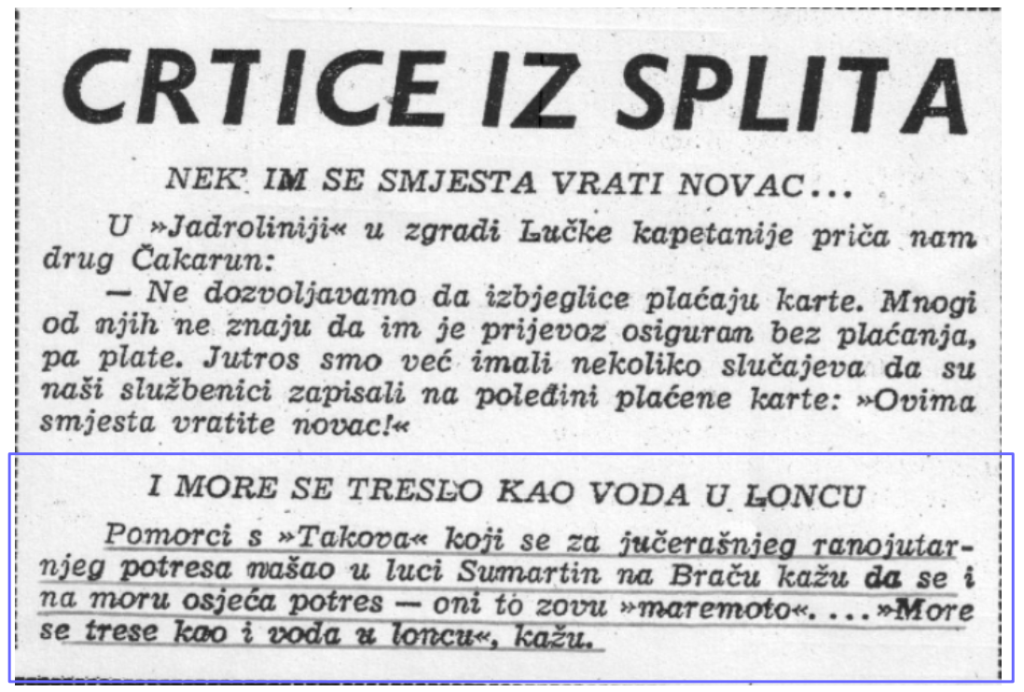Event 14. 11 January 1962, Makarska
In January 1962 Makarska and the surrounding area at the foot of Biokovo mountain was struck by a series of destructive earthquakes. The main shock (M=6.1, I=VIII-IX MCS) was on 11 January at 5h 5min am, four days afer the first destructive shock (M=5.9) (Herak et al., 2001). More than 2000 thousand houses were demolished and kilometers of roads damaged either in the earthquakes or from large blocks of stones that stumbled down the mountain from a height of several hundred meters (Skoko, 1962, Božičević, 1962). The main shock, with epicentre in the sea between Makarska and the islands of Brač and Hvar at a depth between 5 and 20 km, caused vertical sea-bottom displacement of 15 cm and a sea-floor deformation O(10 km) (Herak et al., 2001).
Tide gauge at Split recorded intensification of high-frequency oscillations, starting 40 minutes after the mainshock, with maximum wave height of some 7 cm. This signal would not be sufficient to deduce with certainty that this was a tsunami. However, the event was simulated with a numerical model and the results well reproduced the observed onset time, the wave height and the spectrum contents (Herak et al., 2001), thus showing that a weak tsunami was induced by the earthquake on 11 January.
A number of newspapers reported that people at sea felt at the time of earthquake strong shaking or as if “the vessel had hit an underwater ridge” or saw that “the sea had been trembling like water in a saucepan”. However, all these effects correspond to a seaquake (propagation of seismic p-waves in water) and not to a tsunami. Nevertheless, here are these reports.
“At 7:15 am the ship Vladimir Nazor which runs regularly between Ploče and Split, sailed into the Makarska port. At the time of the earthquake the boat was somewhat more than one (nautical) mile away from the coast, in the direction of Igrane. All the crew has declared that they felt a bump, as if the boat had stranded in full speed against an underwater ridge. All those that were sleeping at the time in their cabins or in the parlour, were awaken by the strength of the shock. … According to the first engine-man Josip Bergam, at the time of the earthquake the steam ship (Budva) was just coming into the port of Igrane. They were about 100 meters away from the quay. They felt a strong shock, which was twice as strong as the one they felt at sea on Sunday. – I was in the engine-room, Josip Bergam told us – and the first thing of what I thought was that we had run in full speed into underwater cliffs and that the ship is mounting onto the coast” (Vjesnik, 1962).
“The earthquake was also felt at sea, so cap. Juraj Borić, the captain of m/b Gusar, helmsman Josip Vela and the sailors, were thrown out of their beds while the ship was at the quay in Podgora … On board ship Takovo, which was at the time at sea between Sumartin and Split, 150 passengers felt a strong shock and the sea became disturbed. Also the passengers, who happened to be yesterday morning on board ship Vuk Karadžić, felt the shock from the earthquake, while the ship was passing through the strait of Splitska Vrata” (Slobodna Dalmacija, 1962, of 12/01).
“The sea also trembled like water in a saucepan. The sailors from the ship Takovo, which was at the time of the earthquake in the port of Sumartin on the island of Brač, say that the earthquake was also felt at sea – they call it maremoto – the sea was trembling like water in a saucepan, they say” (Slobodna Dalmacija, 1962, of 14/01). I = 2, R = 4.
